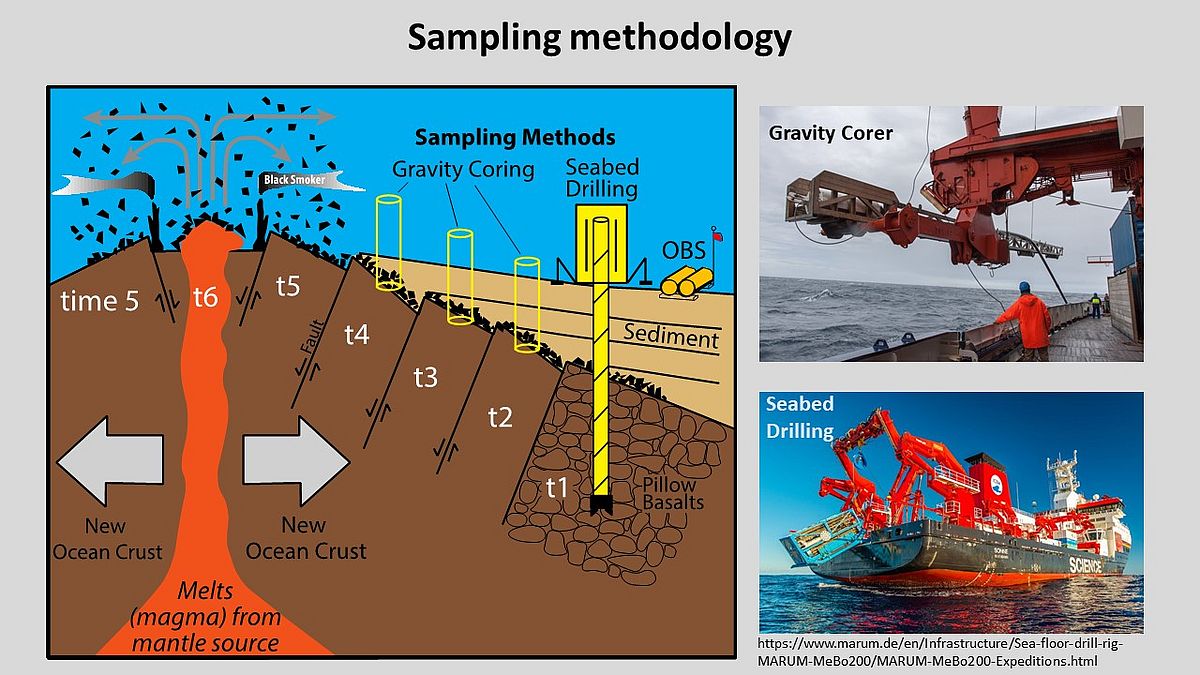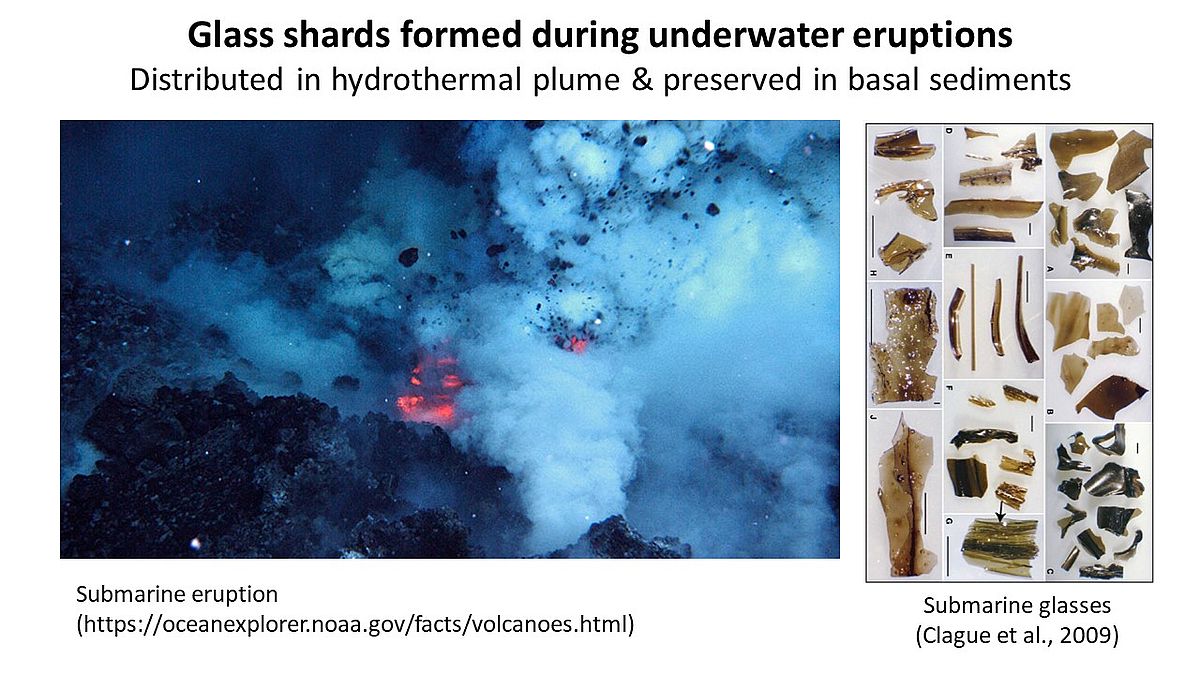T-SECTOR: Testing Solid Earth Climate connections Through mid Ocean Ridge time series
Sediment and rock sampling
Reconstructing the temporal evolution of MORB volcanic activity is challenging, because sediments cover the crust shortly after its formation making it difficult to recover older samples. Also, samples are chemically modified by interaction with seawater. In addition, MORB has very low concentrations of radioactive elements, such as K, used for dating, making it difficult to date individual samples accurately, in particular samples younger than 2Ma and hence of interest for glacial cycles. Recent developments, however, have paved the way for determination of ocean ridge time-series. It is increasingly recognized that MOR effusive eruptions produce volcanic glass fragments that are carried into the overlying water column and then can be disbursed up to 5km from the source by ocean currents.
Depending on their abundance, the glass shards either form layers or are disseminated in sediments near MORs. Furthermore, fresh glass, representing a rapidly-chilled liquid magma composition, is an ideal archive preserving the composition of MORB magmas. The hosting sediments provide a stratigraphic framework for the glasses, from which the temporal evolution of the MORBs can be reconstructed. By application of well established O isotope stratigraphy of benthic foraminifera (ubiquitous carbonate microfossils) in the marine sediment combined with other chronostratigraphic techniques, individual layers can be assigned an age, corresponding to the deposition and formation age of the sediments and enclosed glass shards.
In order to carry out a detailed sampling of the seafloor where there is sediment cover, we propose to use systematic gravity coring to obtain sediment cores up to 20m in length that reach the basaltic basement beneath the sediments. Gravity coring recovers the sediment sequence as preserved on the seafloor and loose samples from the top of the igneous basement trapped by the core catcher. A short multi-corer will also be deployed where gravity coring is carried out to assure undisturbed recovery of the uppermost sediments, not always recovered by long gravity corers. The presence of glass shards at the base of the cores and instantaneous shipboard core logging (sediment color and magnetic properties) of the retrieved sediment cores will guide the coring program, and will be supplemented by high resolution O isotope (d18O) analyses of benthic foraminifera to establish a detailed stratigraphy based on correlation to a well-dated reference record. Such age models will be constructed for the most complete and representative cores, so that they can serve as reference records. Individual cores will be correlated using x-ray fluorescence compositional and magnetic susceptibility scans, regionally extensive tephra layers, and magnetic age data from the basaltic basement. The glass shards from the basal meter of each core from a profile will be combined to produce a detailed geochemical time series. In-situ samples from the igneous basement at the bottom of the sediment cores and obtained by wax coring of exposed abyssal hill tops will be used as anchor points for the glass shard sequences. Using the sediment stratigraphy and igneous basement samples, time series extending to ≥1.5Ma into the past can be constructed with a resolution of 5-10ka if sufficient volcanic glass is available in the sediment.
One cruise will be dedicated to sampling the basaltic crust beneath the sediments by seabed drilling at the Cleft MOR segment. This will provide a time series of basement glass samples from the rims of sheet flows and pillow basalts (located below the sediments), which will be compared to the sediment-hosted glass time series to test how completely and accurately sediment-hosted glasses record variations in MORB chemistry. The elemental and isotope composition of hydrothermal fluids is incorporated into the seawater-derived fraction of the sediments near the vent sites. The composition of the reference sediment cores will thus serve to reconstruct changes in seawater chemistry driven by hydrothermal activity and will be compared to the changes recorded by the glasses and variations in crustal thickness in order to constrain the linkages between crustal composition and production and hydrothermal activity.

The cartoon illustrates the formation of sediment-hosted glass (black fragments) during ocean crust formation and hydrothermal activity. Gravity coring and seabed drilling will be used to sample the sediment sequences and sediment hosted glass within the lowermost sediments. The bottom meter of each core will provide tens of thousands of years of temporal variation in magmatic activity from sediments that can be dated, and by stacking these cores we plan to obtain a time series up to 1.5 million years. That can be compared to sea level, hydrothermal activity and crustal structure and thickness. To ensure that the glass fragments are representative of the crustal composition we will also carry out rock drilling that will sample more than 40m of underlying lava flows.




